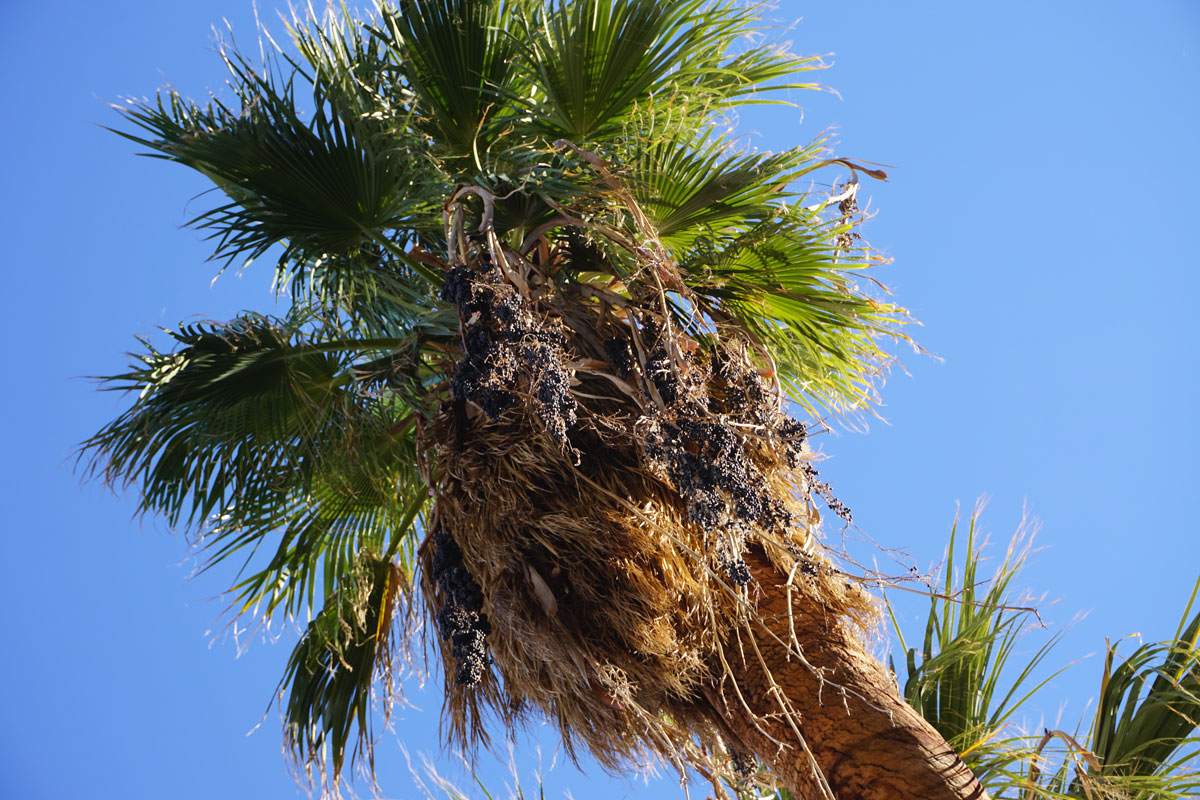Where to go when Texas gets cold? California!
We settled in and reconnoitered the place as we drove around the desert. Traveling in the Thousand Palms Canyon of the Coachella Valley, we found the most delightful haven—the Thousand Palms Oasis.
© 2017 Louise Levergneux, Thousand Palms Oasis
Everything is silent in the oasis and you can immerse yourself in the beauty and solitude of the magnificent palm trees.
© 2017 Louise Levergneux, Thousand Palms Oasis
Stepping into this sanctuary, I was startled by the unexpected lushness of the palms. I absorbed the feathery fronds and admired the stately trunks soaring 60 feet high.
© 2017 Louise Levergneux, Thousand Palms Oasis
Like all palms, the Washingtonia filifera, isn’t actually a tree at all, but is related to grasses and bamboos. Rather than sprouting growth rings, a palm is basically a column that sucks water from the roots to its sprouting crown via a series of drinking-strawlike tubes. The palm trees of this oasis feed on water from the San Andreas Fault line.
© 2017 Louise Levergneux, Thousand Palms Oasis, the skirt of dried leaves hanging down the trunk of the native California fan palm is more than a fashion statement; it’s a home to animals who help the palm propagate
To experience the magnificence of the Preserve, one can trek a two-mile round trip that takes you through a palm oasis, across the fault zone, through a desert wash to the McCallum Oasis, one of the largest groves of desert fan palms in California.
We were enjoying the trek, our boots filling up with desert sand. I stepped on a tiny rock twisted my ankle and my face hit the ground. Argh!
Remember the two-mile round trip, we still had the one mile back to the parking. Yeow!
© 2017 Louise Levergneux, Thousand Palms Oasis, all these photos were shot before the fatal kiss the dirt act
Charles Hobson created a marvelous limited edition artists’ book entitled Trees and it includes a poem by W. S. Merwin. Merwin’s poem is soft and contemplative and conveys a sense of quiet awe as he looked into trees from a mysterious time and place.
© 2010 Charles Hobson, Trees, an edition of thirty copies
When the book is opened, one can read the poem by standing up the first pages and using it to prop each page against it as the pages are turned.
The small tree in the opening at the front of the book is used to suggest the beginning of a recollection of trees in some distant, remembered time, following one of the threads of the poem.
When "accordion’d-out" the book offers a succession of palm trees that can be positioned on different sides of the standing pages, giving a front and back view of the same image. A large architectural model palm tree sits in the window cut in the last panel which is backed by a transparent image of the night sky.
© 2010 Charles Hobson, Trees, 16 pages, 4-1/4 x 12 x 2 inches
The monotypes of palm trees are reproduced as high-resolution digital prints on transparency film. The monotypes lay over the words of the poem, which have been set letterpress to follow the shape of the palm tree trunks – the words of the poem climbing the trees.
© 2010 Charles Hobson, Trees
When one shines the flashlight on the tree and through the opening at the back of the book, the light projects mysterious shadows of trees against the luminous night sky.
The book can be oriented in several ways, much as the poem offers subtly varied interpretations. Setting it on its side presents the type reading from left to right (rather than up and down), but results in the trees having fallen.
© 2010 Charles Hobson, Trees
A stop action animation about the making of Trees with Charles Hobson and Alice Shaw.
You never know what will inspire you and where you will find amazing, superlative ideas.









